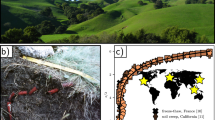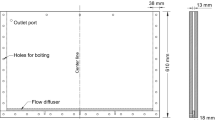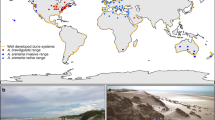Abstract
GEOMETRICALLY regular stripes of stones are found on many unvegetated alpine and polar hillslopes; known as ‘sorted stripes’ because of the characteristic textural sorting between surface stones and fine-grained soil, they contrast markedly with the lack of order typical of natural landscapes. The spacing of the stripes can range from centimetres to metres (about 10–20 times the average stone diameter1,2), with individual stripes extending down-slope for many tens of metres (Fig. 1). A variety of formative mechanisms have been proposed3, but it is still unclear how such orderly stripes can arise spontaneously, and what dictates the spacing. Here we present two-dimensional computer simulations in which the displacement of surface stones is governed by the preferential growth of needle-ice in stone-free regions of soil during each freezing cycle. Regular patterns of stones and soil that closely resemble natural stripes are found to emerge spontaneously from the model as a result of identifiable feedbacks between soil texture, ice growth and local slope.
This is a preview of subscription content, access via your institution
Access options
Subscribe to this journal
Receive 51 print issues and online access
$199.00 per year
only $3.90 per issue
Buy this article
- Purchase on Springer Link
- Instant access to full article PDF
Prices may be subject to local taxes which are calculated during checkout
Similar content being viewed by others
References
Goldthwait, R. Quat. Res. 6, 27–35 (1976).
Noguchi, Y., Tabuchi, H. & Hasegawa, H. Geogr. Ann. A69, 329–342 (1987).
Washburn, A. L. Geocryology, 406 (Wiley, New York, 1980).
Brockie, W. J. Proc. 4th New Zealand Geogr. Conf., 91–104 (1965).
Brockie, W. J. Proc. 5th New Zealand Geogr. Conf., 191–201 (1967).
Mackay, J. R. & Mathews, W. H. Arc. Alpine Res. 6, 347–359 (1974).
Anderson, S. Geol. Soc. Am. Bull. 100, 609–621 (1988).
Hallet, B. Can. J. Phys. 68, 842–852 (1990).
Krantz, W. B. Earth Sci. Rev. 29, 117–130 (1990).
Gradwell, M. W. New Zealand J. Sci. Technol. 38, 793–806 (1957).
Outcalt, S. I. Water Resources Res. 7, 394–400 (1971).
Coutard, J. P., Van Vliet-Lanoe, B., Auzet, C. & Auzet, A. V. Z. Geomorph. N.F. 71, 13–23 (1988).
Ahnert, F. Trans. Jap. geomorph. Un. 2, 301–312 (1981).
Anderson, R. S. Earth Sci. Rev. 29, 77–96 (1990).
Forrest, S. B. & Haff, P. K. Science 255, 1240–1243 (1992).
Author information
Authors and Affiliations
Rights and permissions
About this article
Cite this article
Werner, B., Hallet, B. Numerical simulation of selforganized stone stripes. Nature 361, 142–145 (1993). https://doi.org/10.1038/361142a0
Received:
Accepted:
Issue Date:
DOI: https://doi.org/10.1038/361142a0
This article is cited by
-
Pattern formation in a horizontally shaken granular submonolayer
Granular Matter (2013)
-
A cellular model of braided rivers
Nature (1994)
Comments
By submitting a comment you agree to abide by our Terms and Community Guidelines. If you find something abusive or that does not comply with our terms or guidelines please flag it as inappropriate.



